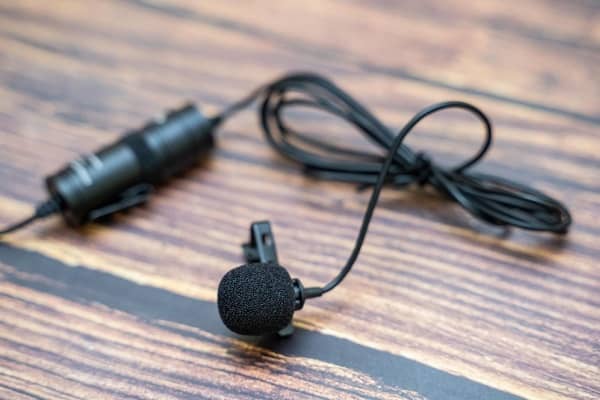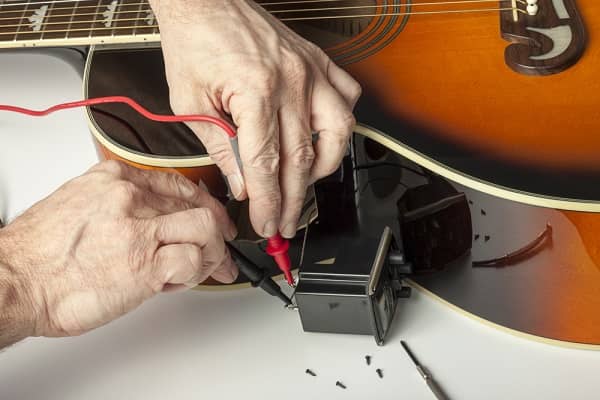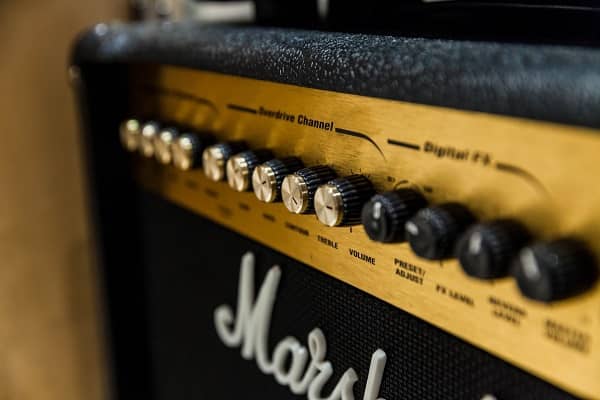If your only guitar is acoustic, but you long for that distinctive electric sound, you’re likely wondering, can you make an acoustic guitar electric? Fortunately, the short answer to this question is a resounding yes.
There are several ways to get an electric guitar like sound out of an acoustic guitar, each with its particular benefits and drawbacks. In the following article, we’ll take a look at each method to help you decide which might work best for your particular needs.
Can An Acoustic Guitar Be Electric?
Yes, an acoustic guitar can be converted to sound like an electric guitar. There are, however, some limitations when it comes to amplifying acoustic guitars. Acoustic-electric guitars are crafted to mitigate some of these limitations, but they deliver a uniquely electric acoustic guitar sound.
Amplifying an acoustic guitar can be as simple as positioning a microphone in front of the soundhole or as involved as permanently installing a pickup on your favorite acoustic.
Acoustic Guitar Convert To Electric
Generally speaking, there are three ways to convert an acoustic guitar into an electric one: you can either use a clip-on pickup, install a vibration response pickup, or permanently install electromagnetic pickups.
Clip-On Pickups

The most inexpensive way to amplify an acoustic guitar is to use a clip-on pickup. Also known as microphone pickups, clip-ons are easy to install and deliver quality sound. One downside to clip-on pickups, though, is that they’re wired; some guitarists report finding the wiring troublesome.
The Monoprice 611060 Clip-on Pickup, available on Amazon for under ten dollars, is a great example of a clip-on pickup. It features an eight-foot cable ending in a standard one-quarter plug and is easily portable.
Vibration Response Preamps
Unlike clip-on pickups, vibration response preamps are wireless. Considerably more expensive than microphone pickups, vibration response pickups are easy to install; all you need to do is place the transmitter behind the bridge of your acoustic guitar, then plug the wireless vibration response preamp into your amp, PA, or midi-interface.
Vibration response pickups produce great quality sound and have a range of about thirty meters, or one hundred feet.
The Fishman Triple Play Wireless Midi Pickup is one example of a quality vibration response preamp, as is Belcat’s UFO-7.
Check out how easily you can make your acoustic guitar electric with this method:

Installing A Pickup
Another way to convert your acoustic guitar into an electro-acoustic is to install a permanent or semi-permanent pickup. A great alternative for guitarists who don’t want to deal with clip-on pickups or soundboard transducers, this method of amplifying your acoustic can be time-consuming and, in some cases, may require you to permanently modify your acoustic guitar.

There are two types of permanent pickups suitable for acoustic guitars; soundhole pickups and piezo pickups. Of the two, soundhole pickups are easier to install and produce a warm, pleasing tone. Piezo pickups are more difficult to install, but they have the benefit of producing less feedback than soundhole pickups.
Most soundhole pickups are designed to fit snugly into and across your guitar’s soundhole, so there’s no need to drill into your guitar to make your acoustic sound more electric. Likewise, piezo pickups require no permanent installation or modification to your beloved instrument.
When choosing a pickup for your acoustic guitar, keep in mind that some acoustic guitar pickups will require you to modify your guitar for installation. If you’d rather not drill into or otherwise modify your instrument, be sure to select pickups that require less-invasive installations.
Soundhole pickups, such as the Donner DSS-6A Mahogany humbucker pickup, and piezo pickups like the Amumu SBT-10 Transducer are budget-friendly options available and require no drilling or modification to install.
Check another demo of installing a soundhole pickup to electrify your acoustic guitar:

Ways To Make An Electro-Acoustic Sound More Like An Electric Guitar
Once you’ve converted your acoustic guitar into an acoustic-electric, you’ll still need to make some adjustments to produce a more electric guitar like sound. Variables ranging from the amp you play through to the strings on your guitar can all affect an amplified acoustic’s tone, and tweaking a few of these variables can help you find that ideal electric sound.
Before going into how, exactly, you can make your amplified acoustic-electric sound more like an electric guitar, it will help to understand a few of the fundamental differences between acoustic-electrics and electric guitars.
Differences Between Acoustic-Electric and Electric Guitars:
Acoustic guitars and electric guitars are designed for different purposes. Acoustic guitars are designed, primarily, to be played without amplification; as such, they use body shape and size to influence sound in ways electric guitars don’t.
Electric guitars were crafted for the opposite purpose; they’re designed to be played amplified. Because of this, electric guitars produce far less natural volume and resonance than acoustic guitars.
Acoustic and acoustic-electric guitars also produce warmer tones with more low-end than electric guitars. This is one of the reasons amplifier choice and EQ adjustments are essential to producing an electric-sounding tone from an acoustic guitar.
Finally, because they create more natural resonance and volume, and because they produce more low-end than electric guitars, acoustic and acoustic-electric guitars are prone to feedback when amplified.
Also Read: Difference Between Acoustic And Acoustic-Electric Guitar
Now that we understand some of the fundamental sound differences between acoustic and electric guitars, let’s look at some tips on how to produce an electric sound from an acoustic guitar.
1. Play Through An Electric Guitar Amplifier
Now that you’ve converted your acoustic guitar into an acoustic-electric, you might be tempted to buy an amplifier designed for such guitars. This is reasonable enough, but if you’re looking to get an electric guitar sound from your acoustic, your best bet is to play through an amplifier designed for electric guitars.
Acoustic-electric guitar amplifiers accentuate tones produced naturally by an acoustic guitar, creating a distinctly acoustoelectric sound. Electric guitar amps are engineered to highlight higher frequencies, such as those produced by electric guitars.
Playing your acoustic-electric guitar through an electric guitar amplifier will help make your acoustic guitar sound more like an electric guitar.
2. Adjust Your Amplifier’s EQ

Once you’ve chosen a suitable electric guitar amp, you’ll still need to dial in some adjustments to its EQ to accommodate your acoustic-electrics prevalent deeper tones and boost its muted higher ones.
To achieve an electric tone from your acoustic, turn down the low frequencies and dial up the highs. Once you’ve got a more electric-sounding tone, you can adjust the mid-level frequencies to your tastes.
3. Avoid Crunch, Overdrive, And Distortion
As mentioned above, acoustic-electric guitars are far more prone to feedback when amplified than electrics. The sound produced by an acoustic guitar reverberates throughout the body and resonates through the soundhole; this is a great advantage when played naturally, but it can create feedback nightmares when trying to play amplified.
Effects like overdrive, distortion, and crunch only make the feedback problems inherent in acoustic guitars worse, and should generally be avoided when playing amplified acoustic guitars.
4. Compression, Reverb, And Delay Can Help
You don’t need to avoid all effects when playing an amplified acoustic, and some can even help you achieve that distinctive electric sound. Compression in particular can go a long way toward making your acoustic guitar sound electric. Other effects like reverb and delay, when used moderately, can also help your acoustic sound more electric.
5. Use A Noise Gate Or Soundhole Cover
Soundhole covers and digital noise gates are two more effective ways of controlling feedback when playing an amplified acoustic guitar. Soundhole covers do exactly what their name suggests; they fit snugly over an acoustic guitar’s soundhole, eliminating many of the stray tones that can produce feedback.
Check out this Planet Waves Acoustic Soundhole Cover.
A more effective, if more expensive, way of dealing with feedback is to use a noise gate pedal. Noise gate pedals allow greater control over your guitar’s tone, and they reduce or eliminate buzzing noise from your signal chain before it reaches your amplifier. Donner’s “Noise Killer” gate pedal is a highly-rated, inexpensive noise gate available on the market.
5. Change Your Strings
It may seem a minor adjustment compared to some of the other suggestions on our list, but changing the strings on your acoustic guitar can go a long way toward helping you achieve that authentic electric sound.
Acoustic guitar strings usually have a steel base plated with either bronze or brass. Most electric guitar strings are fashioned of nickel or steel. If your acoustic guitar’s strings are bronze or brass plated–and they probably are–changing them to steel or nickel will help your acoustic guitar sound more like an electric guitar.
6. Try Putting Paper Between Your Strings And Fretboard
Another trick to help you get an electric sound out of your acoustic guitar is to put a piece of paper, or a playing card, between your guitar’s strings and its fretboard. This technique allows you to get a bit of fuzz from your electro-acoustic guitar without increasing the chances of producing feedback.
If you haven’t tried this technique, or seen other players use it, you likely don’t realize the difference it can make to your tone. The mere fact that Johnny Cash used this trick should be enough to intrigue even the skeptical acoustic-electric guitarist.
About the Author
Fabian, a Brazilian guitarist now based in Dublin, Ireland, has passionately played the electric guitar since 2003. As a luthier and product specialist, he boasts nearly two decades of collaboration with top musical instrument brands. Fabian is a sought-after expert, sharing his extensive knowledge with fellow guitar enthusiasts.


